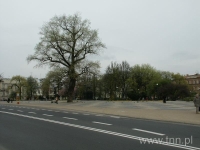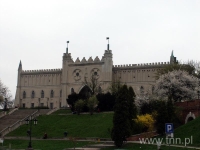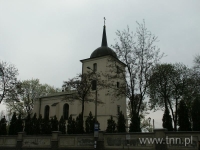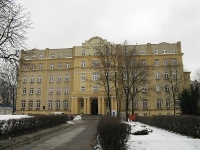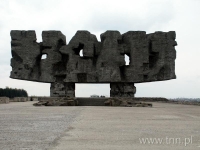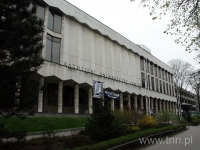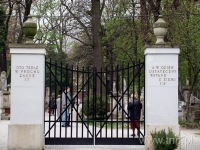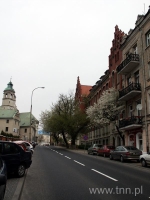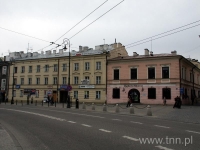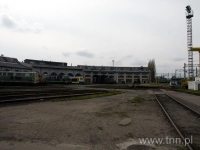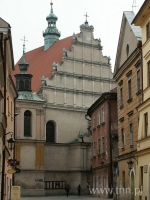Guidebook to Lublin - “From the Union of Lublin to the European Union” (educational path)
Creation of the educational path called “From the Union of Lublin to the European Union” in 2004 was related to Poland’s accession to the European Union. Along the path, there are places that played a vital role in history of Lublin and of Poland.
Index
[Collapse]- Map of the route
- 1st stop: Litewski Square
- 2nd stop: Lublin Castle and the castle hill
- 3rd stop: Orthodox church on Ruska Street
- 4th stop: Chachmei Lublin Yeshiva (Pol. Jesziwas Chachmej Lublin - The School of the Sages of Lublin)
- 5th stop: Majdanek
- 6th stop: John Paul II Catholic University of Lublin (Pol. Katolicki Uniwersytet Lubelski Jana Pawła II, abbr.: KUL)
- 7th stop: cemetery on Lipowa Street
- 8th stop: Bernardyńska Street
- 9th stop: Królewska Street
- 10th stop: PKP roundhouse
- 11th stop: Dominican church and monastery
Map of the route
Show Guidebook to Lublin - “From the Union of Lublin to the European Union” on a big map
1st stop: Litewski Square
2nd stop: Lublin Castle and the castle hill
The first settlement complex had been located on the castle hill in the 12th century, while already during the Jagiellonian period, the castle served as king’s accommodation. In 1569, the castle was the venue of debate and then confirmation by oath of the Union of Lublin act. As a result of wars in the 17th century, the castle was destroyed - the romanesque keep and the gothic Holy Trinity Chapel are the only remaining parts of that complex. From 1824 to 1826, a new neo-gothic building, designed as a prison, was being erected on the hill. In 1954 this building was adopted for the cultural purposes. Accommodating the Lublin Museum since 1957, the castle symbolises two totalitarian regimes of the 20th century: Hitlerism and Stalinism, which left their distinct stamp on the history of the whole Europe. During the Second World War, soldiers of AK (Pol. Armia Krajowa - Home Army) and WiN (Pol. Wolność i Niezawisłość - Freedom and Independence) had been imprisoned here. They were later persecuted by the communist authorities. The castle is also a part of the history of the Jewish community of Lublin. Up until the end of the World War II, the Jewish district had been located in Podzamcze, constituting a significant religious and cultural centre. In 1941 Nazis established the ghetto, which was razed after all the Jewish inhabitants had been murdered.
>>>read more about the history of the Lublin Castle
3rd stop: Orthodox church on Ruska Street
The Transfiguration of Jesus Orthodox church is a building related to the history of Lublin Orthodox and Uniate communities. Today’s building, built on the site of a wooden church from the 16th century, was completed in 1633, with masonry ornaments bearing distinct features of the Lublin Renaissance style. With separated central segment, once covered with a cupola, and an impressive Iconostasis from the 1st half of the 17th century, the church is a typical example of a building designed for the eastern rite liturgy. Throughout its history, the church changed hands between Orthodox and Uniate communities numerous times, whereas in the 1695-1864 period, it was a property of Basilian monks. The church has functioned uninterrupted since it was built. It is also the seat of the Orthodox Bishop, Abel.
4th stop: Chachmei Lublin Yeshiva (Pol. Jesziwas Chachmej Lublin - The School of the Sages of Lublin)
History of the Chachmei Lublin Yeshiva - talmudical (also called rabbinical) academy in Lubartowska Street - is closely related to the history of the Jewish community in Lublin. It followed the tradition of the former Yeshiva, established in 1518 under the privilege given by Sigismund II Augustus. The building was erected between 1924 and 1930, on initiative of Rabbi Meir Shapiro, who, for several previous years, had been raising funds among members of Polish and foreign Qahals, with intention to build a modern academy, along with a dormitory. Apart from lecture halls and library containing one of the most abundant judaistic collections in the country, the building also housed a synagogue for students, lecturers and local residents, and a mockup of the Jerusalem Temple. Chachmei Lublin Yeshiva, strengthening Lublin’s status as the centre of Jewish orthodoxy, was regarded one of the most modern schools of this type in the whole world and many of its graduates became famous rabbis. After the war its name was taken over by a rabbinical academy in Detroit.
>>>read more about the edifice of the yeshiva
5th stop: Majdanek
In the autumn of 1941, by decision of Hitlerist authorities, construction of a concentration camp for 50 thousand prisoners had begun on the outskirts of Lublin. Gas chambers and crematory were also built, when in 1942 Nazis started exterminating Jews. According to various estimations, 170 000 to 235 000 people perished here. Most of them were Jewish citizens of Poland and other european countries, as well as Poles, Ukrainians and Russians. Prisoners were executed, died because of harsh living conditions, famine and diseases, or were killed in gas chambers. Mass execution was carried out on November 3 1943, when 18 thousand Jews were shot dead. The camp was liberated in July 1944 and in November of that year, the State Museum in Majdanek was established on its grounds. The colossal Monument to the Victims of Majdanek, erected in 1969, contains ashes of people who perished in the camp.
6th stop: John Paul II Catholic University of Lublin (Pol. Katolicki Uniwersytet Lubelski Jana Pawła II, abbr.: KUL)
On Fr. Idzi Radziszewski’s initiative and with financial support from Polish industrialists Karol Jaroszyński and Franciszek Skąpski, University of Lublin had been established in 1918 and in 1944 renamed as Catholic University of Lublin. Initially, the seminary served as university’s seat, but already in 1919 Chief of State (Pol. Naczelnik Państwa), Józef Piłsudski handed over the so-called świętokrzyskie barracks (Pol. świętokrzyskie - “of the Holy Cross”), i.e. buildings of the former Dominican Observantines monastery, along with the church of Holy Cross, to the university. Since the dissolution of the monastery in 1800 and subsequent acquisition by Austrians, those premises were used as a military hospital and later as barracks. While the building was being adapted to suit university’s needs, the arcade cloisters (following the form of those in Wawel) that had been walled up by Russians, were restored and windows were fit into them. Thanks to endeavors of Fr. Radziszewski, who became the first rector of the university, the former monastery/barracks complex was adapted for university between 1920 and 1930. In the 1970s a new façade was constructed, along with the segment that accommodates administration offices and a representative lecture hall. In the post-war period KUL was the only catholic university in the Eastern Bloc to be recognized not only as an important scientific centre, but also as a facility being in opposition to the communist regime. KUL played a vital role in the 1970s and during the martial law period, accepting students and professors expelled from state universities in Warsaw and Cracow, among others, as a part of the political persecutions. In 1981 Czesław Miłosz and Lech Wałęsa visited the university, whereas in 1987 so did John Paul II, erstwhile professor of KUL.
7th stop: cemetery on Lipowa Street
Cemetery on Lipowa St. is one of the most beautiful places of that kind in the whole Poland, often being compared to the Powązki cemetery in Warsaw or Rossa in Wilno. Founded in 1794 as a catholic graveyard, it became a multi-confessional cemetery in the late 19th century. German inscriptions on the gravestones adjoin orthodox crosses and memorials of catholic and protestant families, notable for their merits for the city. Despite protestant and orthodox parts of the cemetery being separated from the catholic one, collective graves of evangelical-catholic mixed families, located on the borderline, are a peculiarity of this place. Speaking of meritorious people buried here, it is worth to mention, among others, members of the Vetter family, priest Piotr Ściegienny, writer Klemens Junosza-Szaniawski, bibliophile Hieronim Łopaciński, poet Józef Czechowicz, and writer Józef Łobodowski. In the western part of the cemetery, there is a military graveyard of Austrian, German, Russian and Polish soldiers who were killed in Lublin and surrounding areas.
8th stop: Bernardyńska Street
Located in the very centre of the city, Bernardyńska Street is closely related to the history of industry and educational system in Lublin, at the same time reminding of city’s multicultural heritage. Top section of the street runs along Bernardine monastery and church of an interesting shape, in Lublin Renaissance style. In 1569, after the Union of Lublin act had been signed, a thanksgiving mass took place in that very church. Across the street, there is a small building with balcony decorated with a statue of Adam Mickiewicz. It was the first seat of Stanisław Staszic Gymnasium. A stately edifice of red brick located nearby accommodates the A & J Vetter Economic Schools of Lublin that follow the tradition of business school built between 1906 and 1907, funded by the family of famous industrialists, originating from Germany. Vetters were also proprietors of the brewery situated a little farther, where, apart from beer, vodkas and liquors had been produced since 1859. In the nearby palace, once belonging to Sobieski and later to Radziwiłł families, a modern steam powered mill was working in the 2nd half of the 19th century. The boilermaker workshop of Albert Plage was located somewhat farther. In times of industrial prosperity at the turn of the 20th century, numerous industrial plants were being located in vicinity of the railway and along the road that was an extension of Bernardyńska and Zamojska streets, leading towards Piaski, Krasnystaw and Zamość. Among those facilities, worth mentioning are especially Emil Plage and Teofil Laśkiewicz’s Mechanical Works, producing, among others, boilers and food industry equipment. In the interwar period, production of aircraft and bodywork for Chrysler, Buick and Hotchkiss passenger cars was started in that factory.
9th stop: Królewska Street
Królewska Street, formerly called also “Lwowskie Przedmieście” (“Lviv Suburb”), runs along the onetime city walls. Owing to the privileges given by kings Stefan Batory and Sigismund III Vasa, first apartment houses were built here already in the early 17th century. Between 1636 and 1658, church and monastery complex in baroque style was built, currently owned by Jesuits. In the 1st half of the 19th century, presentable mansions of meritorious Lublin families were situated on the street. Królewska St. is closed with the monumental edifice of John the Baptist and John the Evangelist arch-see. Its facade, in the early Baroque style, relates in its form to the church of the Jesuits of Rome - Il Gesu. Inside, there is the miraculous painting of the Mother of God, famed for the storied miracle in 1949, when tears appeared on the face of painted Madonna. The Cathedral Square in front of the church was the venue of the oath ceremony of the Polish Armed Force (Pol. Polska Siła Zbrojna) in 1918. It was also the starting point for marches towards the Litewski Square, like, among others, manifestations preceding the strikes in July and August 1980. The seat of the local authority of NSZZ Solidarność trade union is located in the upper part of Królewska St. In 1980s this was a vital meeting point.
10th stop: PKP roundhouse
Between 16 and 18 July 1980, roundhouse was the venue of the last of the series of strikes that took place in various industrial plants of the Lublin region, beginning in WKS Świdnik on July 8. Agroma Agricultural Machinery Manufacture, LZNS, FSC, ZA Puławy, EDA in Poniatowa and many others went on strike afterwards. Strike at the Lublin railway junction caused a wave of other strikes to eventually turn into almost a general strike, which forced communist authorities to engage in negotiations. Apart from the economic demands, there were also social and political ones, for instance a demand of free elections to the Works Council (pol. Rada Zakładowa). Railwaymen of Lublin cherish the memory of those events, which is signified, among others, by a commemorative iron cross standing in the place where the strike began.
11th stop: Dominican church and monastery
History of the Dominican church and monastery, honoured with the title of minor basilica by pope Paul VI in 1967, reaches back to the 13th century. The building acquired its current form in the turn of the 17th century, when it was restored in original gothic style after being destroyed by fire in 1575. Its noteworthy architectural form combines elements of Gothic and Lublin Renaissance styles with many Baroque and Rococo ornaments. Inside, worth seeing are, among others, Tyszkiewicz and Firlej families’ chapels, The Fire of the City of Lublin - painting from 1740 as well as painting, famed for miracles, of The Mother of God of The Tribunal (Pol. Matka Boska Trybunalska), to whose protection the townsmen of Lublin resorted before presenting their cases in front of the Tribunal. For ages the basilica has been famous for being the place where the relics of the Holy Cross were kept. Legend has it, that they had been given to the monks by prince Grzegorz - ruler of Ruthenia and Kiev. Table on which the act of the Union of Lublin is believed to have been signed, is kept in the monastery’s treasury. Basilica is also the place where on July 1 1569, after the oath had been taken and seal had been affixed to the act of the Union of Lublin in the castle, the first thanksgiving service took place and Te Deum was sung, attended by king Sigismund. Through the ages, the church has been visited by all of the Polish monarchs, who prayed in front of relics of the Holy Cross.
>>>read more about the Basilica of St. Stanislaus and Dominican monastery in Lublin
Material compiled by Joanna Zętar
Translated by Jarosław Kobyłko

